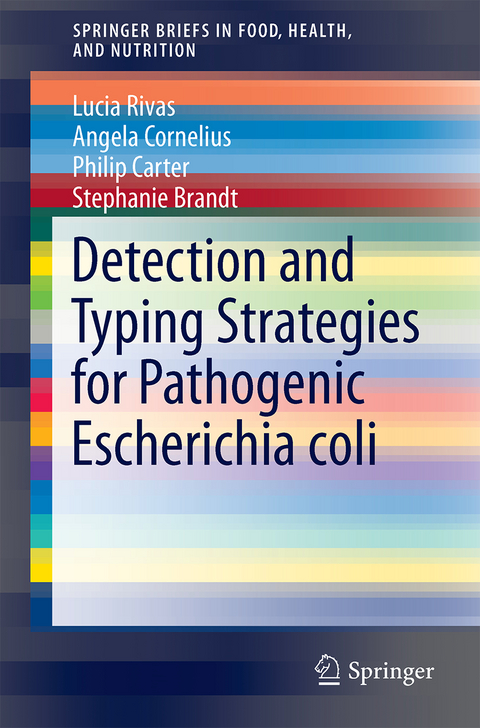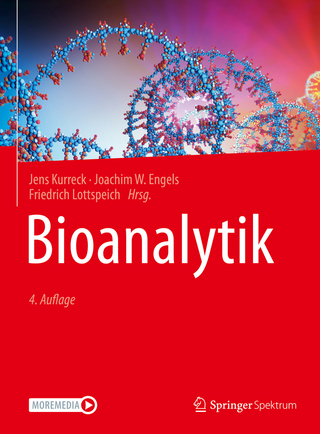
Detection and Typing Strategies for Pathogenic Escherichia coli
Springer-Verlag New York Inc.
978-1-4939-2345-8 (ISBN)
This Brief will review the methods that are currently available for the detection, isolation, and typing of pathogenic E. coli with a particular focus on foodborne diseases caused by the Shiga toxigenic E. coli group, which have been implicated in a number of significant outbreaks in recent years. Pathogenic forms of E. coli can cause a variety of diarrheal diseases in hosts due to the presence of specific colonization and virulence factors, and pathogenicity-associated genes, which are generally not present in other E. coli. Six pathotypes of pathogenic E. coli are recognized (Shiga toxigenic E. coli, Enteropathogenic E. coli, Enterotoxigenic E. coli, Enteroinvasive E. coli, Enteroaggregative E. coli and Diffusely Adherent E. coli) and certain strains among these groups are major public health concerns due to the severity of disease that they can cause. Methods to detect and isolate these pathogens from a variety of sources are constantly evolving. In addition, the accumulation of knowledge on these pathogens allows for improved intervention strategies.
Chapter 1 Introduction to Pathogenic Escherichia coli.- 1.1 Pathotypes of Escherichia coli causing diarrhoeal diseases.- 1.2 Escherichia coli.- 1.3 Pathogenic types of E. coli.- 1.4 Shiga toxin-producing and Enterohemorrhagic E. coli.- 1.4.1 Virulence determinants of Shiga-toxin producing E. coli.- 1.4.2 Shiga-toxin producing E. coli-mediated disease.- 1.4.3 Epidemiology of Shiga toxin-producing E. coli.- 1.4.4 Ecology of Shiga-toxin producing E. coli.- 1.4.5 Transmission of Shiga-toxin producing E. coli.- 1.4.6 Shiga-toxin producing E. coli occurrence in foods.- 1.5 Enterotoxigenic E. coli.- 1.6 Enteropathogenic E. coli.- 1.7 Enteroinvasive E. coli.- 1.8 Enteroaggregative and Diffusely Adherent E. coli..-1.9 References.- Chapter 2 Isolation and detection of pathogenic Escherichia coli in foods.- 2.1 Introduction.- 2.2 General method of isolation for E. coli.- 2.3 Shiga toxin-producing E. coli.- 2.3.1 Culture and isolation of Shiga toxin-producing E. coli.- 2.3.2 Molecular detection of Shiga toxin-producing E. coli.- 2.4 Enumeration of Shiga toxin-producing E.coli.- 2.5 Immunological detection methods for pathogenic E. coli.- 2.6 Cell culture assays used for pathogenic E. coli.- 2.6.1 Cell cytotoxicity assay for Shiga toxin-producing E. coli.- 2.6.2 Cell adherence assays.- 2.7 Enteroinvasive E. coli.- 2.8 Enterotoxigenic E. coli.- 2.9 Enteropathogenic E. coli.- 2.10 Enteroaggregative E. coli and Diffusely Adherent E. coli.- 2.11 References.- Chapter 3 Typing and Subtyping methods for pathogenic Escherichia coli.- 3.1 Introduction.- 3.2 Biochemical profiling.- 3.3 Serotyping.- 3.4 Phage typing.- 3.5 Multilocus enzyme electrophoresis.- 3.6 Multilocus sequencetyping.- 3.7 Pulsed-field gel electrophoresis.- 3.8 Multiple-locus variable number tandem repeat analysis.- 3.9 Repetitive element palindromic polymerase chain reaction.- 3.10 Random amplified polymorphic DNA.- 3.11 Shiga toxin subtypes and bacteriophage insertion sites.- 3.12 Lineage specific polymorphism analysis.- 3.13 Whole genome sequencing.- 3.14.- References.- Chapter 4 Emerging and future trends and technologies for the detection and typing of Escherichia coli.- 4.1 Future trends in foodborne illness and E. coli.- 4.2 Future trends in the detection and typing of pathogens.- 4.2.1 Microarrays.- 4.2.2 Matrix Assisted Laser-Desorption Ionization-Time-Of-Flight Mass Spectrometry.- 4.2.3 Nanotechnology.- 4.2.4 Next-generating sequencing of the whole bacterial genome.- 4.3 References
| Reihe/Serie | SpringerBriefs in Food, Health, and Nutrition |
|---|---|
| Zusatzinfo | 5 Illustrations, color; 1 Illustrations, black and white; VI, 110 p. 6 illus., 5 illus. in color. |
| Verlagsort | New York |
| Sprache | englisch |
| Maße | 155 x 235 mm |
| Themenwelt | Naturwissenschaften ► Biologie ► Mikrobiologie / Immunologie |
| Technik ► Lebensmitteltechnologie | |
| Technik ► Umwelttechnik / Biotechnologie | |
| Schlagworte | detection strategies • isolation strategies • pathogenic escherichia coli • Pathogens • Typing methods |
| ISBN-10 | 1-4939-2345-5 / 1493923455 |
| ISBN-13 | 978-1-4939-2345-8 / 9781493923458 |
| Zustand | Neuware |
| Haben Sie eine Frage zum Produkt? |
aus dem Bereich


